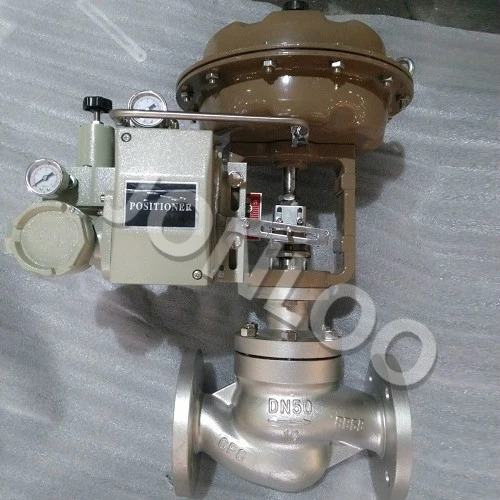A control valve is a valve used to control fluid flow by varying the size of the flow passage as directed by a signal from a controller. This enables the direct control of flow rate and the consequential control of process quantities such as pressure, temperature, and liquid level.
They are available in numerous kinds of shapes and designs.
The Steam control valves consist of a body with trim, bonnet and pneumatic actuator, optionally with metal bellows or insulating extension. The valves may be also equipped with electric, electro-hydraulic, or hand-operated actuators, as well as control accessories and other instrumentation.There are a lot of different control valves, but the main one used for flow control is a globe valve. In general, a control valve either controls pressure or flow (they can also control things like temperature or level in a vessel, but both of those are really flow you care about, as far as the valve is concerned).
Pressure control is pretty intuitive, if you need more pressure upstream, the valve closes; if you need less pressure, the valve opens to allow flow out. Flow control operates by changing the hydraulic resistance of your system. Need more flow? Valve opens, system has less resistance, pump needs less pressure to get through and moves farther right on its curve where it has more flow.
Why control valves are there and what they do. As far as how they do it, take a look at this picture, which shows a regular manual globe valve’s internals. Control valve trim are the parts that are in direct contact with the fluid being controlled. They are should be chemically and thermally compatible with the fluid for a long service life, readily replaceable or renewable and to augment the force applied by the actuator as well as compatible with the control loop to enhance loop stability. Care should be given to select trim for a tight shut off, to avoid cavitation at low flow fluid flows and for ease of disassembly and sanitizing for food contact. You will also need to consider if the valve is designed to be open or closed with lose of actuator power i.e. air to open or air to close.The seat moves up and down to allow more or less flow through the valve.
In a control valve, your seat is moved by an actuator. Take a look at this picture of a control valve actuator.
Air pressure coming into the top bulb will move the diaphragm down at higher pressure or allow it to raise at lower pressure, which will move the valve seat in the corresponding directions. Do note that some valves are air-to-close (the image above) and some are air-to-open, where you would need to apply the air pressure to the bottom of the diaphragm to open the valve. This assumes you have pneumatic control(air) but many industries use electronic or hydraulic actuators as well.
If you need good quality steam control valve, pls come to JONLOO.

